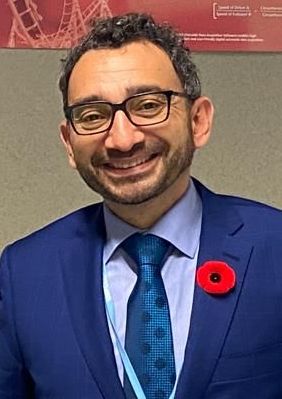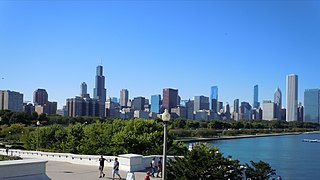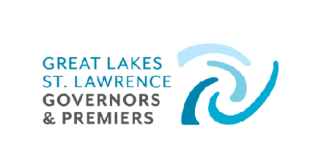
Canada, the world's second-largest country in total area, is dedicated to having an efficient, high-capacity multimodal transport spanning often vast distances between natural resource extraction sites, agricultural and urban areas. Canada's transportation system includes more than 1,400,000 kilometres (870,000 mi) of roads, 10 major international airports, 300 smaller airports, 72,093 km (44,797 mi) of functioning railway track, and more than 300 commercial ports and harbours that provide access to the Pacific, Atlantic and Arctic oceans as well as the Great Lakes and the St. Lawrence Seaway. In 2005, the transportation sector made up 4.2% of Canada's GDP, compared to 3.7% for Canada's mining and oil and gas extraction industries.

The St. Lawrence Seaway is a system of locks, canals, and channels in Canada and the United States that permits oceangoing vessels to travel from the Atlantic Ocean to the Great Lakes of North America, as far inland as Duluth, Minnesota, at the western end of Lake Superior. The seaway is named for the St. Lawrence River, which flows from Lake Ontario to the Atlantic Ocean. Legally, the seaway extends from Montreal, Quebec, to Lake Erie, and includes the Welland Canal. Ships from the Atlantic Ocean are able to reach ports in all five of the Great Lakes.

The United States secretary of transportation is the head of the United States Department of Transportation. The secretary serves as the principal advisor to the president of the United States on all matters relating to transportation. The secretary is a statutory member of the Cabinet of the United States, and is fourteenth in the presidential line of succession.

The St. Lawrence River is a large river in the middle latitudes of North America. Its headwaters begin flowing from Lake Ontario in a roughly northeasterly direction, into the Gulf of St. Lawrence, connecting the American Great Lakes to the North Atlantic Ocean, and forming the primary drainage outflow of the Great Lakes Basin. The river traverses the Canadian provinces of Ontario and Quebec, as well as the U.S. state of New York, and demarcates part of the international boundary between Canada and the United States. It also provides the foundation for the commercial St. Lawrence Seaway.

The United States Department of Transportation is one of the executive departments of the U.S. federal government. It is headed by the secretary of transportation, who reports directly to the President of the United States and is a member of the president's Cabinet.
Independent agencies of the United States federal government are agencies that exist outside the federal executive departments and the Executive Office of the President. In a narrower sense, the term refers only to those independent agencies that, while considered part of the executive branch, have regulatory or rulemaking authority and are insulated from presidential control, usually because the president's power to dismiss the agency head or a member is limited.
The United States federal executive departments are the principal units of the executive branch of the federal government of the United States. They are analogous to ministries common in parliamentary or semi-presidential systems but they are led by a head of government who is also the head of state. The executive departments are the administrative arms of the President of the United States. There are currently 15 executive departments.
Canada Steamship Lines (CSL) is a shipping company with headquarters in Montreal, Quebec, Canada. The business has been operating for well over a century and a half.

The minister of transport is a minister of the Crown in the Canadian Cabinet. The minister is responsible for overseeing the federal government's transportation regulatory and development department, Transport Canada, as well as Canada Post, the Saint Lawrence Seaway, Nav Canada, and the Port Authority system. Since 12 January 2021, the position has been held by Omar Alghabra of the Liberal Party.

The modern terms short-sea shipping, marine highway, and motorways of the sea, and the more historical terms coastal trade, coastal shipping, coasting trade, and coastwise trade, all encompass the movement of cargo and passengers mainly by sea along a coast, without crossing an ocean.
In Canada and the United States, a port authority is a governmental or quasi-governmental public authority for a special-purpose district usually formed by a legislative body to operate ports and other transportation infrastructure. In Canada, the federal Minister of Transport selects the local chief executive board member and the rest of the board is appointed at the recommendation of port users to the federal Minister; while all Canadian port authorities have a federal or Crown charter called Letters Patent.
Executive Schedule is the system of salaries given to the highest-ranked appointed officials in the executive branch of the U.S. government. The president of the United States appoints individuals to these positions, most with the advice and consent of the United States Senate. They include members of the president's Cabinet, several top-ranking officials of each executive department, the directors of some of the more prominent departmental and independent agencies, and several members of the Executive Office of the President.
The St. Lawrence Seaway Management Corporation (SLSMC), formerly known as the St. Lawrence Seaway Authority, is a nonprofit Canadian Corporation established in 1998 by the government of Canada, in partnership with Seaway users and other stakeholders, in order to ensure safe and efficient marine traffic. As dictated by the 1998 Canada Marine Act, the Corporation manages and operates the assets of the Crown entrusted to St. Lawrence Seaway, which consists of lands, Canals and 13 of the 15 locks between Montreal and Lake Erie, for the government under a long-term agreement with Transport Canada".

The Seaway International Bridge is an international crossing connecting New York State, in the United States, Akwesasne Mohawk Territory, and the province of Ontario in Canada. It consists of the South and North Channel Bridges. The South Channel Bridge was opened in 1958, and spans the St. Lawrence Seaway. The North Channel Bridge, opened in 2014, connects the City of Cornwall in Ontario to Cornwall Island in Akwesasne Mohawk Territory.
The Water Resources Development Act of 1986 is part of Pub. L. 99–662, a series of acts enacted by Congress of the United States on November 17, 1986.

The Great Lakes megalopolis consists of the group of metropolitan areas in North America largely in the Great Lakes region. It extends from the Midwestern United States in the south and west to western Pennsylvania and Western New York in the east and northward through Southern Ontario into southwestern Quebec in Canada. It is the most populated and largest megalopolis in North America.

The Conference of Great Lakes and St. Lawrence Governors and Premiers is a North American intergovernmental organization led by the governing chief executives of the Canadian provinces of Ontario and Québec and the US states of Illinois, Indiana, Michigan, Minnesota, New York, Ohio, Pennsylvania, and Wisconsin. Through the organization, they seek to grow the region's economy and protect the Great Lakes. The organization began in 1983 as the Council of Great Lakes Governors to encourage and facilitate environmentally responsible economic development. The Council now serves as secretariat to the Governors’ Compact Council and the Governor and Premiers’ Regional Body.

The United States Committee on the Marine Transportation System (CMTS) is an inter-agency committee authorized by the United States Coast Guard and the Maritime Transportation Act of 2012 to coordinate policies affecting the U.S. Marine Transportation System (MTS).

Adam Tindall-Schlicht is an American government official, who is currently serving as the eleventh Administrator of the Great Lakes St. Lawrence Seaway Development Corporation. President Joe Biden appointed Tindall-Schlicht to the role of GLS Administrator on November 6, 2022.













